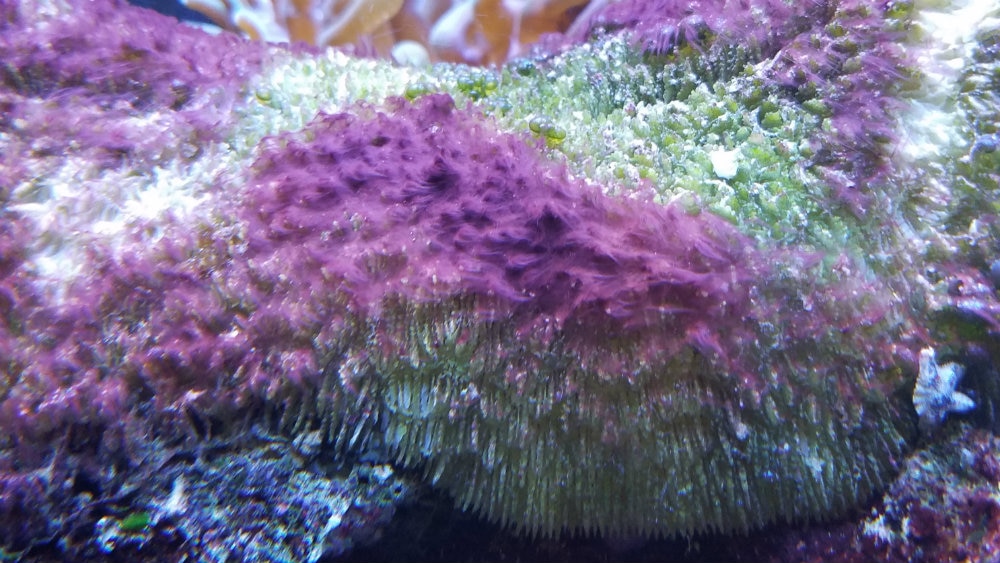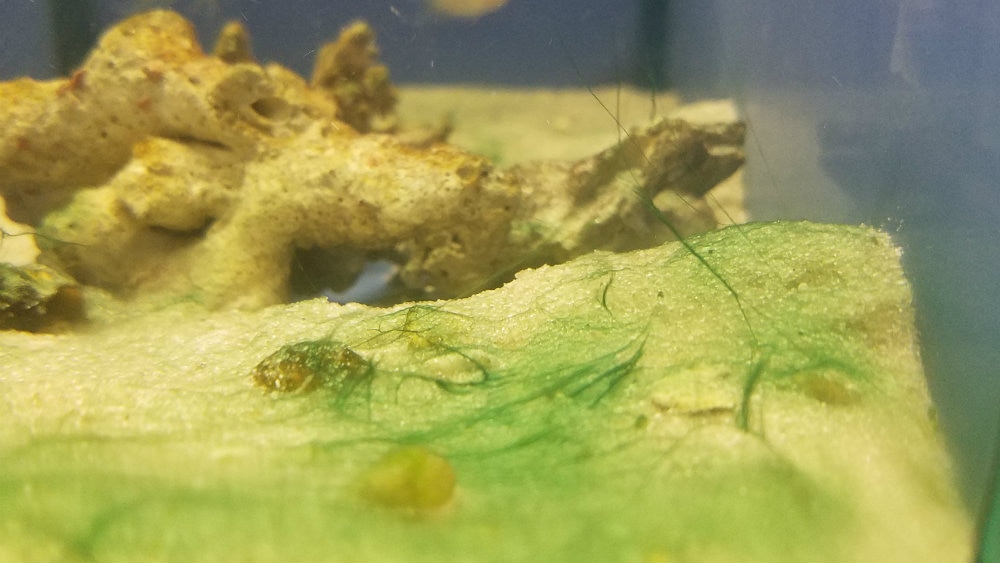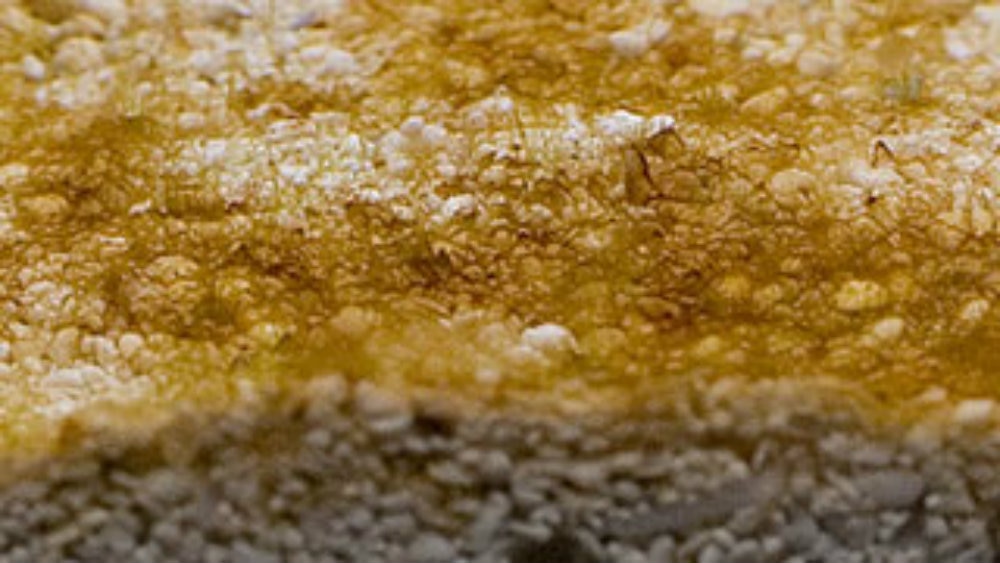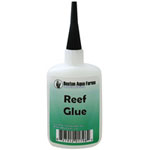“Slime algae” is a common problem with aquarists of all levels but getting rid of it can be tricky. The name “slime algae” is a misnomer and what may looks like a slime in your tank could be a number of different problems or, more commonly, a symptom of a number of different problems. The key to getting rid of it is to identify and eliminate the cause rather than just treating the symptom.
As with most aquarium problems, diagnosing this problem starts with testing your water quality. Water tests are just like vital signs at a doctor’s office and can point to or eliminate a lot of different problems in an aquarium. In addition to the four core water tests – Ammonia,Nitrite, Nitrate, and pH – testing the Phosphate level is also important in algae and algae-like issues like this. We’ll go into more detail later with how each parameter may be causing your problem and how they can be used to solve it.
Next, take a look at the “slime” itself…we’ll use these different appearances to help narrow down which you might be seeing in your tank. What color is the algae – red, green, black, brown, white? What is the texture like – thick and mat-like, a thin coating, wispy, cloudy? Do you notice it growing anywhere particular on the tank – only on the substrate or a certain ornament, in a circulation deadspot, only towards the top? Can it be easily brushed away? Are there bubbles forming beneath it?
Now to the different “slimes”…

Thick and mat-like, usually dark red (especially in saltwater) or dark green (especially in freshwater). Bubbles form underneath the mats and it is easy to brush off of surfaces.
This is the most common “slime algae” that aquarists encounter but it isn’t actually an algae at all even though it may behave like one. This is Cyanobacteria (often simply called “cyano”). Cyanobacteria are bacteria that manufacture their own food and live in colonies — large enough for you to see them! It’s these colonies that cause trouble for aquarists. They are not necessarily blue-green but can be black, green, blue green, and the familiar dark red sheets covering many surfaces in an aquarium.
The first thing aquarists who find an unwanted colony of cyanobacteria in their aquarium want to know is how to get rid of it. Well, this is where it gets tricky. To eradicate the problem, the particular trigger for the cyano bloom must be identified and treated. Not every bloom is in response to the same trigger and while throwing a chemical at the problem will perhaps clear it up temporarily, it will come back, and it will be worse. Cyano has a few common causes:
- High Nitrates (NO3-)/Dissolved Organic Carbon (DOC): These two parameters go hand-in-hand and are often interchangeable for an aquarist’s purposes. Nitrate and DOC is a food source of the bacterial side of the bacteria-algae. Sources include: fish slime, algae, bacteria, digested/uneaten food, metabolic waste, live food, some aquarium additives etc.
- Key Appearance: The cyano with this cause will grow fairly indiscriminately anywhere in the tank where it gets light. This is usually the thickest mats of cyano.
- Solution: This is best done by frequent water changes, good water movement (power heads and closed system circulation ) and (this is important!) a good protein skimmer (for saltwater tanks only). An undersized or ineffective protein skimmer, high waste loads, or a combination thereof will increase the dissolved carbon level. As a rule of thumb for skimmers; buy one that is rated for at least twice the size of your tank. It may take some adjusting but a properly functioning skimmer can remove ½ cup of thick organic scum from a tank a day. Also, watch what you feed. Feed once a day. If you wish to feed twice, simply split the amount in half – don’t feed twice as much food. If you feed grocery store bought seafood or are making your own foods, rinse all foods thoroughly as seafood sold for human consumption is treated with phosphates and preservatives to keep it fresher longer. (It’s true!) Avoid flake foods, these dissolve too fast – pellets and crisps are much better and more palatable.
- High Phosphates (PO43-): This level is similar to the Nitrates above and may come from some of the same sources. It is used as a preservative in some foods as mentioned, but is usually the result of the water source. If you are using tap water, be sure to test the water before adding it to your tank, especially if it is well water or if you are in an area with a lot of agriculture and run-off. You can also check with your municipality if you use a municipal or “city” water source since Phosphate may not be removed in all areas.
- Key Appearance: Similar to above.
- Solution: Frequent water changes with Phosphate-free water. If your water source already has high Phosphate levels before it even makes it to your tank, consider installing an RO/DI (Reverse Osmosis/Deionization) Unit . This filtering system removes all impurities (including Phosphate, Nitrate, and DOC). If you already have an RO/DI Unit, make sure all the membranes are installed correctly and changed regularly. If you aren’t able to install your own unit, many stores like ours sell RO/DI water by the gallon. Filter medias are also available to help remove Phosphates faster than water changes alone.
- Lighting:The food source for the algal side of the bacteria-algae is light. This is becoming less common as LED lighting is replacing older fluorescent aquarium lighting but if you are still using fluorescent bulbs, check on the age of your bulbs. Light bulb spectra (the “color” of the light) shift as they age, resulting more favorable conditions for photosynthesis to take place more vigorously. Older bulbs become more yellow in color and the “good” plants and algae can’t use this spectrum as well as the “bad” algae and cyano can.
- Key Appearance: If lighting is the cause, you are most likely to see the cyano forming in the most brightly-lit areas of the tank with the most direct light. Since light wave penetrate differently through the water column, you may see a gradient in the cyano growth from top to bottom.
- Solution: Replace old bulbs. If your fluorescent bulbs are older than 6-8 months, it is time to replace them. Even if they still “look” bright, the color will have started degrading. If you are able to, consider switching to an LED fixture. In addition to being much more energy efficient, they don’t age and lose their spectrum in the same way fluorescent bulbs will.
- Poor Circulation: In this case, you may see cyano in only certain areas of the tank like corners or areas sheltered by rockwork. In these areas, the circulation is blocked or can’t reach sufficiently and any waste can build up before it can be removed by the filter. This provides a captive food source for the cyano.
- Solution: Rearrange your tank or install powerheads or pumps to increase the circulation. Consider upgrading your filter as well if it isn’t powerful enough for the tank size.

Thin and wispy sheets, usually on the substrate and especially in freshwater tanks. Usually green, brown, or blue-green
Trick question! This is also Cyano. This appearance is more common in freshwater tanks and in higher-flow environments where the Cyano can’t settle into thick mats. The same causes and solutions above still apply.
It should also be mentioned that there are chemicals to “treat” Cyano. Cyano is a gram negative (thin cell membrane) bacteria, much like most bacteria in the aquatic environment. A dose of Erythromycin will knock out the colony of slime quite quickly and this is the active ingredient in most Cyano chemicals on the market. However, since the nitrifying bacteria you need in your tank are gram negative as well, they will be affected also, either being killed or severely damaged. This treatment is more advisable in freshwater aquaria, but only with careful attention paid to water quality while treating. Like all antibiotics, if dosed frequently the cyano will develop a resistance. This should be a short-term fix only, and the problem leading to the cyano bloom in the first place still has to be addressed to eliminate it for good.

Thin light brown coating on exposed surfaces, especially in new aquariums (less than 4-6 weeks) or in tanks that have recently been “restarted” with a large water change (over 40-50%), medication, or other event
A few weeks after the tank has started cycling (after live rock, fish or a bacteria culture has been added), you may see a thin brown film covering the surfaces and sides of the tank. This film scrapes or wipes off easily and cutting back lighting doesn’t seem to affect it. No snails, hermit crabs or fish feed on it, but critters moving across the substrate or glass tend to stir it up enough so it “goes away.” So, what is going on at this point?
The “algae” you see is not a type of plant with cells like traditional green algae that most people think of. It is actually made up of diatoms, a type of phytoplankton whose cell walls are primarily made up of the mineral silicate. It blooms towards the end of the cycling process in a tank because of the imbalance of nutrients in the system but will usually die off on its own once the water chemistry in the tank stabilizes. This is what we commonly refer to as “New Tank Syndrome” (NTS).
- Solution: Just wait! As tricky as it may be, the best tool to combat NTS is patience. Once the cycle progresses and the tank becomes established, this diatom bloom will exhaust itself and fade away on its own. You can clean the sides of the tank and stir up the substrate to break up the algae, but avoid the temptation to do water changes or add any algacides at this point….this will only cause the cycle to take even longer to finish and the NTS will keep coming back. Most tanks take about 4-8 weeks to cycle, depending on the bioload and size of the tank.
- For more information, see our article Explaining the Nitrogen Cycle.

White, mold-like coating often isolated to a single ornament (especially natural ornaments like driftwood) in a freshwater tank
This is usually a sign of fungus or decomposition. If the “slime” is translucent in appearance, it is more likely to be a fungal growth. This is common on ornaments that may have been left outside and exposed to airborne spores, or on pieces washed with some detergents. If possible, remove the piece from the aquarium and scrub it thoroughly in a bucket of tank water or under warm running water. Spider Wood especially is notorious for becoming moldy when first added to a tank but will usually dissipate on its own in time.
If the “slime” is more opaque in color and easily brushes away, something is decomposing. If this is a natural material like a once-dried-out starfish or another animal, dispose of it…it will only continue to decompose and harm the water quality. If it is a harder object like a piece of wood, you can try cleaning it like described above but if it continues to soften or fall apart, it likely just isn’t a safe type of wood and should be replaced as well.
These are just a few of the most common “slime”-related issues we encounter often but are far from everything you may experience. We have come across some really unusual circumstances that have turned out to be related to something as seemingly unconnected as an oil-diffuser air freshener in an outlet near the tank. Feel free to let us know if you need help troubleshooting with your own tank!
Originally published September 9, 2008. Updated May 13, 2020.
 That Fish Blog – Aquarium Advice and Information
That Fish Blog – Aquarium Advice and Information




I also have recently had slime, but colourless, mostly in my sump. It is almost (clear) mucuslike. Slippery slimy, but again, colourless (and odorless). What might this be?
Regards,
HUGO
It could just be a coat of naturally occurring bacteria, probably nothing to worry about. May also be residual material from fish and inverts in the tank, also not anything that should harm the tank. Cyanobacteria is dark and unsightly, easily recognizable.
Hi, Thanks for the reply. Probably not dangerous, but very annoying, because it cloggs up my pumps and skimmer. Anyway, by coincidence, I have had to take out EVERYTHING due to a leakage in a seal. Have been able to clean sandbed and more than 50% waterchange. We’ll see how it goes, now we are of on a holiday. Thanks again.
I have the same problem as Hugo slippery slimmy colorless, odorless slime what might this be? Can anybody tell me can that harm my betta and how can I get rid of it?
Selena, this is most likely just a bacterial slime, and most likely harmless. Bacteria is going to grow on all surfaces of your tank, and is nothing to worry about it.
never had problems in 5 years of keeping Oranda but just few weeks have sudden appearance of masses of slime (like frogspawn) everywhere. Cleaned everything, scrubbed stones, tank etc. but a week later it’s back and worse. My fish are staying at the top of the water and looking unhappy! Can someone please help as I’m getting desperate?
Hello Janet, What are the water parameters (pH, Ammonia, Nitrite, Nitrate, temperature at least), how large is the tank, and how many fish are in it? How often do you do water changes and how much do you change? If you have any photos of the mass you are seeing, you can email them with information about your tank to fish@thatpetplace.com and if you would like to speak with someone about your tank issue, you can call us at 717-299-5691.
Hello Eileen, thanks for your response. So sorry I have not replied before now but I have been away and have since been quite poorly. I am not sure of water parameters exactly but check with the plastic sticks regularly and pH,Ammonia levels always ok. I change the water about once a month – normally leave about a third of the tank water taken from the top as its cleaner. I only have two fish both about 4″ long and the tank is 27L. I am still getting this problem. The slime is clear to pale brown, and the tank really smells bad which it never did before. Any ideas would be welcome, thank you!
Hello Janet, 27 liters (or about 7 gallons) is very small for any 4-inch fish, much less for goldfish that you mentioned back in December. It sounds like it might be a water quality issue. I would recommend having your water tested for pH, Ammonia, Nitrite, and Nitrate to start with. You mention “plastic sticks”. If you are referring to test strips, those are notoriously inaccurate and have a very short shelf life. Having the actual values of these tests would be helpful. With fish that large in such a small tank, it sounds like the filter isn’t able to keep up with the waste and that would be causing the smell and slime. Even one goldfish at that size should have at least a well-filtered 30 gallon (100-125 liter) tank.
I also have the problem with the slime and smell, my question is would it attract mosquito, as my pumps not working very well.
Hello Angie, Are you referring to an outdoor pond or an indoor aquarium? Mosquitoes will be attracted to standing water to lay their eggs but that isn’t usually an issue on indoor aquariums. If the “slime” you are seeing is accompanied by a bad smell, it is likely not the cyanobacteria referred to in this article but is rather likely due to a combination of inadequate filtration, overcrowding and/or overfeeding. It is difficult for me to say without knowing more about the pond/aquarium you have, how large it is, what is in it, the water chemistry, etc.. Fresh activated carbon and water changes will help you control those symptoms in the meantime while you diagnose the cause of them.
Is this cyanobacteria slime the same translucent white stuff that sometimes accumulates on suction cups and rubber parts of heaters in new aquariums?
I set up an aquarium two weeks ago, and about a week later started seeing that while slime on my heater’s rubber parts. I clean it off every couple of days, but it comes back in about two days. There are quite a few posts online from people who have the same thing, so apparently it’s common. I’d appreciate any help you can offer.
Hello Lou, Cyano wouldn’t be white. Black, green, blue-green or red, but not white. I would say that you are probably experiencing what is commonly known as “New Tank Syndrome” or you might be seeing a fungus growing on those surfaces. I would expect that more on leftover food than on equipment but if there are spores or too many nutrients in the water, it is possible. If you would like to send us some photos of this “white stuff” you are seeing with some basic info about your tank (at least its size, a list of any livestock in it, water parameters like pH, temperature, Ammonia, Nitrite and Nitrate levels to start with), someone here can take a look at it and try to diagnose it more accurately for you. You can send those photos as attachments to fish@thatpetplace.com.
There is only one permanent fix to this problem. Sufficient aeration of the water.
The ONLY time EVER that I’ve seen green slime algae become a problem in ANY tank regardless of water quality is when there is not enough dissolved oxygen in the water. With sufficient aeration, it goes away completely on it’s own.
It makes sense, cyanobacteria require a low-oxygen environment to live. If anyone has a bead on another common and plausible cause, I’d be interested to hear it. But I’ve never encountered it before. The advice online is good… water quality… etc… etc. But when I see it, I’ll believe it.
The fish seem to survive just fine in these low-oxygen tanks covered in green slime, but mine seemed much more lively once I fixed the problem.
Hello atsaunders, Low oxygen may certainly contribute to the problem but I would disagree that it is the primary cause and aeration is the only solution. Other issues like poor spectrum lighting and water chemistry certainly feed into it as well. The reason you may see it in more heavily aerated tanks is because the cyano develops air pockets under the mat which make it semi-buoyant. Aeration in the tank will help dislodge the mats and allow it to be picked up by the filtration easier. This is why it is also often seen in areas of low flow; with sufficient flow, it will be disturbed enough to become dislodged and filtered. Without eliminating the cause – be it low oyxygen or poor light quality or excess nutrients – the cyano will always return.
For a few quick references from scientific sources on the causes of cyanobacteria (particularly in natural environments, you can check out these sources from the Environmental Protection Agency, World Health Organization, Centers for Disease Control and Prevention, and the Australian Department of the Environment.
Hello I would like to know if anyone knows what this clear gel like substance is in my fish tank. I recently cleaned everything in it and scrubbbed everythung really well. New grave, new sand and a bubble wand. I scrubbed my decirations really well. I have a picture that I can send to anyone that’s wolling to help me figure out what it is.
Hello John, You can email us at fish@thatpetplace.com and someone here can try to help you with your tank. Please include as much information about your tank as possible – size, types of livestock in it, water paramteres (actual test values of pH, Ammonia, Nitrite, Nitrate at least as well as Salinity if it is a saltwater tank), how long the tank has been set up, what maintenance you regularly do, etc.. The more information you can give us and the better your photos are, the more likely we’ll be able to help you.
I have a 5 plecos in a 46 gallon tank. Six inch sail fin, two 5 inch green phantoms, two 3 inch royal, and three 1 1/2 albinos. They eat romaine lettuce, carrots and cucumber. I do a 50% weekly water change. If I don’t rinse off the filter media every few days, the 2 Marineland 400 Emperor HOB filters will clog with a huge amount of brown gelatinous sludge. The HOB filters then need to be taken apart and cleaned biweekly. The tank also has clown loaches, mollies, corys, and angels, but I don’t they contribute as much waste as the plecos. A whole cucumber, carrot, or lettuce heart is rapidly converted to waste and then sludge, which winds up in the filter. A garden hose is the best way to clean the filters.
Hi Tom, It sounds like the “slime” you are seeing is more a result of overcrowding and waste rather than the cyanobacteria discussed here. That is a lot of large, high-waste fish for a tank that small even before knowing the sizes and quantities of the other fish you mentioned. I would recommend upgrading the size of your aquarium or cutting down on the number of plecos in it, which will also allow you to feed less.
Hello there! I am setting up a new tank. It is a 12 gallon Fluval Edge. It has been running for 5 weeks and the ammonia levels, nitrate levels, nitrite levels are good as tested with API testing drops. I was finally ready to do a water change to prepare for fish introduction and was arranging my natural driftwood in the tank. When lifting one of the pieces, I discovered a thick slimy orange substance on the bottom of the log – the part that was in contact with my medium sized gravel. The other pieces were clear. Originally, before putting the store bought driftwood in to the tank, I had boiled it for 2 hours.
I have a photo of that is helpful. Any advice you can give would be appreciated! Thank you, in advance.